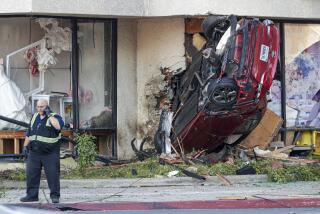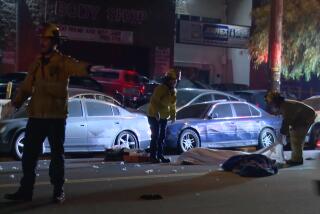Traffic fatalities fall for fifth straight year
Reporting from Washington — The number of traffic fatalities fell for the fifth year in a row in 2010, dropping 3% to its lowest level since 1949, according to estimates released by the U.S. Department of Transportation on Friday.
Fatalities fell from 33,808 in 2009 to 32,788 last year, despite the fact that Americans drove nearly 21 billion miles more in 2010 than in the year before.
That works out to about 1.09 deaths for every 100 million miles traveled, a major drop from 1972, when traffic deaths peaked at 54,589 and there were 4.33 deaths for the same number of miles traveled.
The trend has continued despite yearly increases in population, the number of cars on the road and miles driven. Since 2005, traffic fatalities have fallen by 25%, with a particularly large drop of almost 10% in 2009.
“I think people really are aware of safety, and people really are aware of personal responsibility,” said Transportation Secretary Ray LaHood. “These things will only increase our ability to reduce deaths on the road, so I’m certainly encouraged by the trend.”
LaHood named public awareness campaigns, including those that advocate seatbelts and discourage distracted driving, graduated driver’s license programs that give teen drivers limits such as nighttime curfews and a maximum number of passengers, harsher drunk driving laws and more effective law enforcement as factors in the drop.
Regionally, the largest decline in fatalities was 12% in the Pacific Northwest states of Washington, Oregon, Montana and Idaho, followed by 11% drop in California and Arizona, according to the DOT. Fatalities increased in the Great Lakes region and in the Northeast.
Safer road design and improved vehicle safety are also major factors in the reduction in fatalities, said Barbara Harsha, director of the Governors Highway Safety Assn.
“With safer roadways there are improvements like rumble strips, median barriers and pavement markings, Harsha said. “With vehicles, air bags and stability control have been particularly key.”
After dropping in the first two quarters of 2010, traffic deaths actually increased slightly in the third and fourth quarters of the year (by 1.6% and 1.8%, respectively), but Harsha said this likely isn’t an indication that the trend of fewer fatalities is reversing.
“That’s fairly typical because the third quarter is the warmer months,” she said. “More people are driving, there are more motorcyclists and so on. So that’s pretty predictable, and I think you see that every year.”
Roy Lucke, director of research at Northwestern University’s Center for Public Safety, said when new safety technology is introduced, it’s usually too expensive to put in most cars, but as technology has become cheaper, safety has become much more accessible to the average driver.
Side airbags, antilock brakes and traction control are all examples of now-common safety features that used to be limited to only the most expensive vehicles, he said.
“What used to be a high-end option on a Mercedes is now standard equipment on a Ford,” Lucke said. “The safety features that were first introduced on high-end cars are rapidly becoming standard on all vehicles, particularly in the last 10 years.”
He added that a change in the attitude of the American people may be one of the most influential factors on the drop in traffic fatalities.
“The philosophy of safe driving is beginning to become more and more ingrained in society,” Lucke said. “Nationally, we’re seeing 90% seatbelt usage in some states, there are changes in child seats and how they’re used -- there’s a large number of people who are weighing in on what’s safest, and that just wasn’t part of the collective consciousness just a few years ago.”
But Lucke sounded a note of caution, saying that distracted driving is on the increase, as people continue to call, text and even watch TV on their cellphones while they’re in the driver’s seat.
More to Read
Sign up for Essential California
The most important California stories and recommendations in your inbox every morning.
You may occasionally receive promotional content from the Los Angeles Times.










